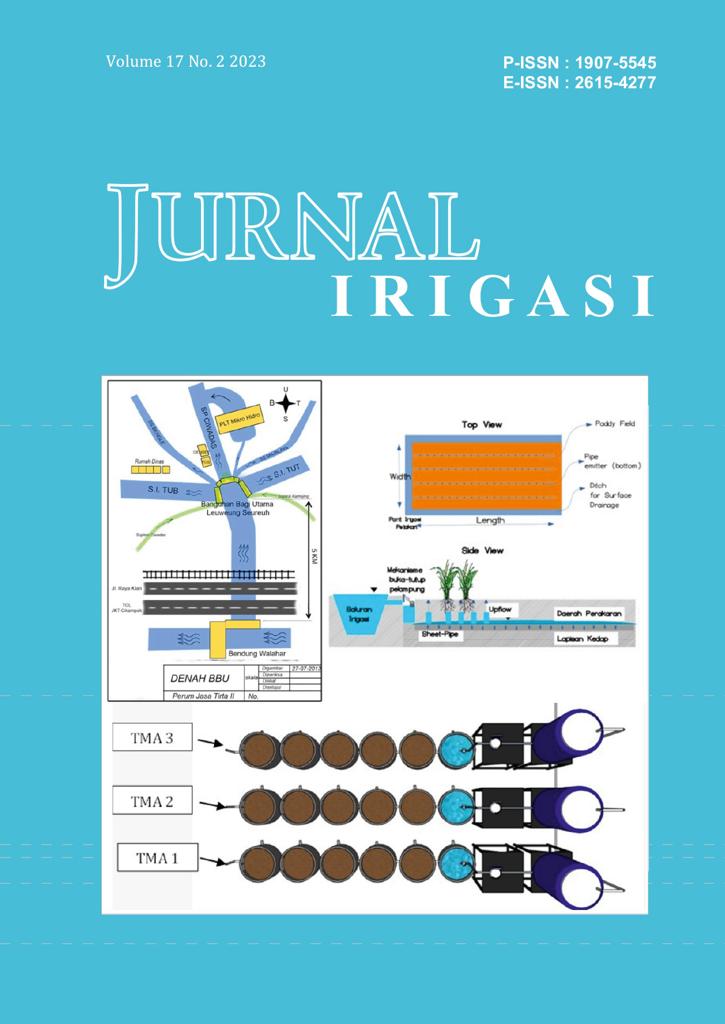Software development for analyzing the adaptability of irrigation infrastructure to climate change
DOI:
https://doi.org/10.31028/ji.v17.i2.1-11Keywords:
Climate-proof, Climate Change, Cropping Intensity, Peak Discharge Requirement, MATLAB, EXCELAbstract
Computer software for climate-proof irrigation infrastructure has been developed. The software is designed to compute decreasing cropping intensity and increasing peak discharge requirements due to climate change. To be user friendly, the data input and output are written in MS Excel file format, which is widely used in engineering calculation. The tool has been tested in the North Tarum Irrigation scheme with a total irrigation area of 85.287 hectares, consisting of 126 secondary blocks. Based on the calculation, climate change will decrease cropping intensity from 100% up to 71% from October to March and from April to September, it will decrease the cropping intensity from 83% to 54% for all scenarios of climate change (RCP_2.6 to RCP_8.5). Because climate change will increase evapotranspiration, and in several months will decrease precipitation, then the peak discharge requirement will also affect. In the main Leuweung Seureuh Weir, the peak discharge will increase from 72.18 m3/sec up to 76.14 m3/sec. Consequently, the discharges in the canal downstream are also increasing. In the primary canal North Citarum East (SI TUT), the discharge will increase from 29.58 m3/sec to 30.63 m3/sec while primary canal North Citarum West (SI TUB), the discharge will increase from 34.12 m3/sec to 36.18 m3/sec.
Downloads
References
Al-Kalbani, M., Price, M., Abahussain, A., Ahmed, M., & O’Higgins, T. (2014). Vulnerability Assessment of Environmental and Climate Change Impacts on Water Resources in Al Jabal Al Akhdar, Sultanate of Oman. Water, 6(10), 3118–3135. https://doi.org/10.3390/w6103118
Amisigo, B., McCluskey, A., & Swanson, R. (2015). Modeling Impact of Climate Change on Water Resources and Agriculture Demand in the Volta Basin and other Basin Systems in Ghana. Sustainability, 7(6), 6957–6975. https://doi.org/10.3390/su7066957
Boer, R., Faqih, A., Ardiansyah, Kolopaking, L., Rakhman, A., Nurbaeti, B., & Anria, A. (2013). Rencana Aksi Mitigasi dan Adaptasi Perubahan Iklim dalam Kerangka Pengelolaan Sumber Daya Air di DAS Citarum di Kabupaten Bandung Barat. Bekasi, Indonesia: BPLH Kabupaten Bekasi.
Boer, R., & Suhartono, Y. (2012). Climate Change and Its Impact on Indonesia’s Food Crop Sector. Presented at the The Sixth Executive Forum on Natural Resource Management: Water & Food in a Changing Environment, Los Banos, Philippines.
Direktorat Irigasi dan Rawa. (2013). Standar Perencanaan Irigasi—Kriteria Perencanaan Bagian Perencanaan (KP-01). Jakarta: Direktorat Jenderal Sumber Daya Air, Kementerian Pekerjaan Umum.
Elliott, J., Deryng, D., Müller, C., Frieler, K., Konzmann, M., Gerten, D., … Wisser, D. (2014). Constraints and potentials of future irrigation water availability on agricultural production under climate change. Proceedings of the National Academy of Sciences, 111(9), 3239–3244. https://doi.org/10.1073/pnas.1222474110
Europian Comission. (2021). Technical Guidance on The Climate Proofing of Infrastructure in the Period 2021-2027 (Commission Notice). Retrieved from https://ec.europa.eu/ newsroom/cipr/items/722278/
Hukom, E., Limantara, L. M., & Andawayanti, U. (2012). Pengaruh perubahan iklim terhadap optimasi ketersediaan air di irigasi Way Mital Propinsi Maluku. Jurnal Teknik Pengairan: Journal of Water Resources Engineering, 3(1), 24–32.
Jaya, O., Purba, A., & Despa, D. (2022). Optimalisasi pengendalian laporan pola tanam bidang irigasi dalam bentuk aplikasi Exel secara online di lingkup Seksi Pengembangan Sumber Daya Air di Dinas PU dan Tata Ruang Kab. OKU Timur. In Prosiding Seminar Nasional Ilmu Teknik dan Aplikasi Industri (Vol. 5, pp. 104–108). Lampung, Indonesia: Fakultas Teknik Universitas Lampung. https://doi.org/ 10.23960/prosidingsinta.v5i.70
Lee, J.-L., & Huang, W.-C. (2014). Impact of Climate Change on the Irrigation Water Requirement in Northern Taiwan. Water, 6(11), 3339–3361. https://doi.org/10.3390/w6113339
Lestari, W. S., Suprayogo, D., & Prijono, S. (2019). Analisis kerentanan sistem irigasi akibat perubahan iklim dengan tolok ukur indeks kelentingan di empat daerah irigasi wilayah Daerah Aliran Sungai Brantas. AgriTECH, 38(4), 413–423. https://doi.org/10.22146/ agritech.11202
Septri, P. (2015, January 20). Analisis Perubahan Pola Tanam Dan Indeks Pertanaman Padi Sawah Akibat Perubahan Iklim Di Daerah Irigasi Koto Tuo (Diploma Thesis). Universitas Andalas, Padang, Indonesia. Retrieved from http://scholar.unand.ac.id/10961/
Serang, R. (2012). Pengaruh perubahan iklim terhadap optimasi ketersediaan air di Daerah Irigasi Golek Kecamatan Pakisaji Kabupaten Malang dengan mempergunakan program linier. Jurnal Teknik Pengairan: Journal of Water Resources Engineering, 3(1), 15–23.
Sofiyuddin, H. A., & Rahmandani, D. (2019). Akselerasi waktu pelaporan operasi irigasi menggunakan perangkat lunak berbasis web Sistem Manajemen Operasi dan Pemeliharaan Irigasi (SMOPI). Jurnal Irigasi, 14(2), 63–78. https://doi.org/10.31028/ji.v14.i2.63-78
Ulfa, F. (2021). Analisis Identifikasi Perubahan Iklim dan Pengaruhnya terhadap Kinerja Jaringan Irigasi Embung Penyaring di Kabupaten Sumbawa (Graduate Theses). Universitas Mataram. Retrieved from http://eprints.unram.ac.id/26981/
Downloads
Published
How to Cite
Issue
Section
License
Copyright (c) 2023 Jurnal Irigasi

This work is licensed under a Creative Commons Attribution-ShareAlike 4.0 International License.
This work is licensed under a Creative Commons Attribution-ShareAlike 4.0 International License.
